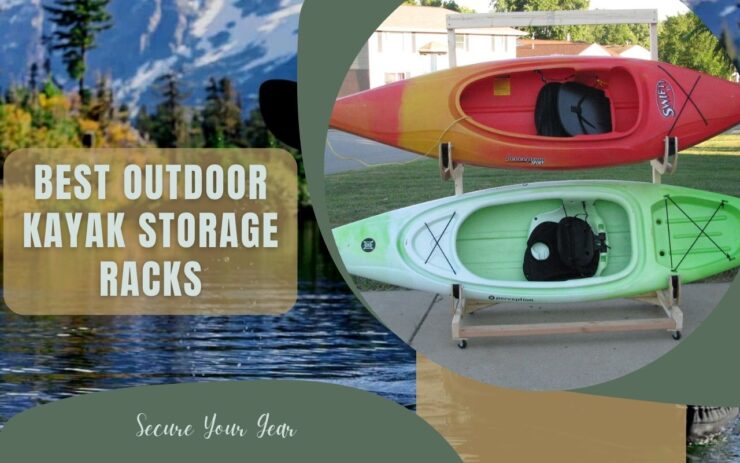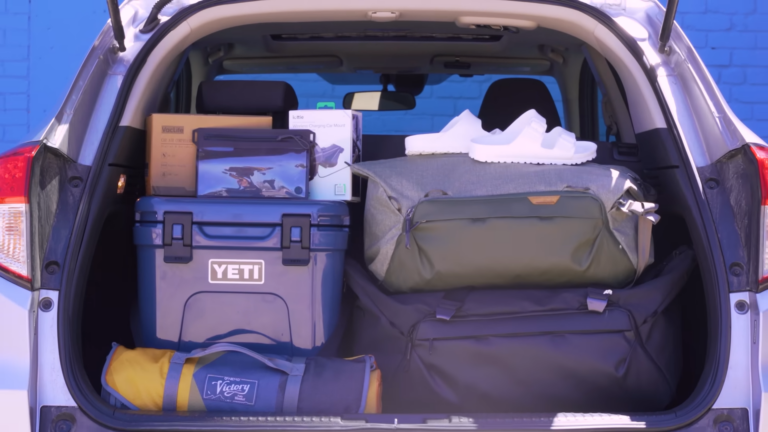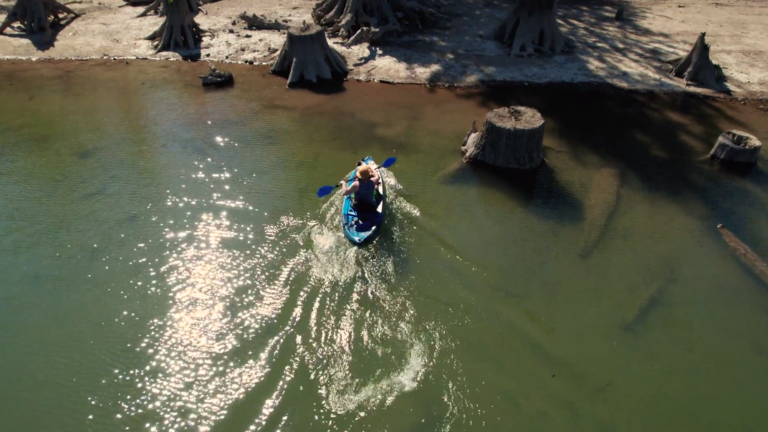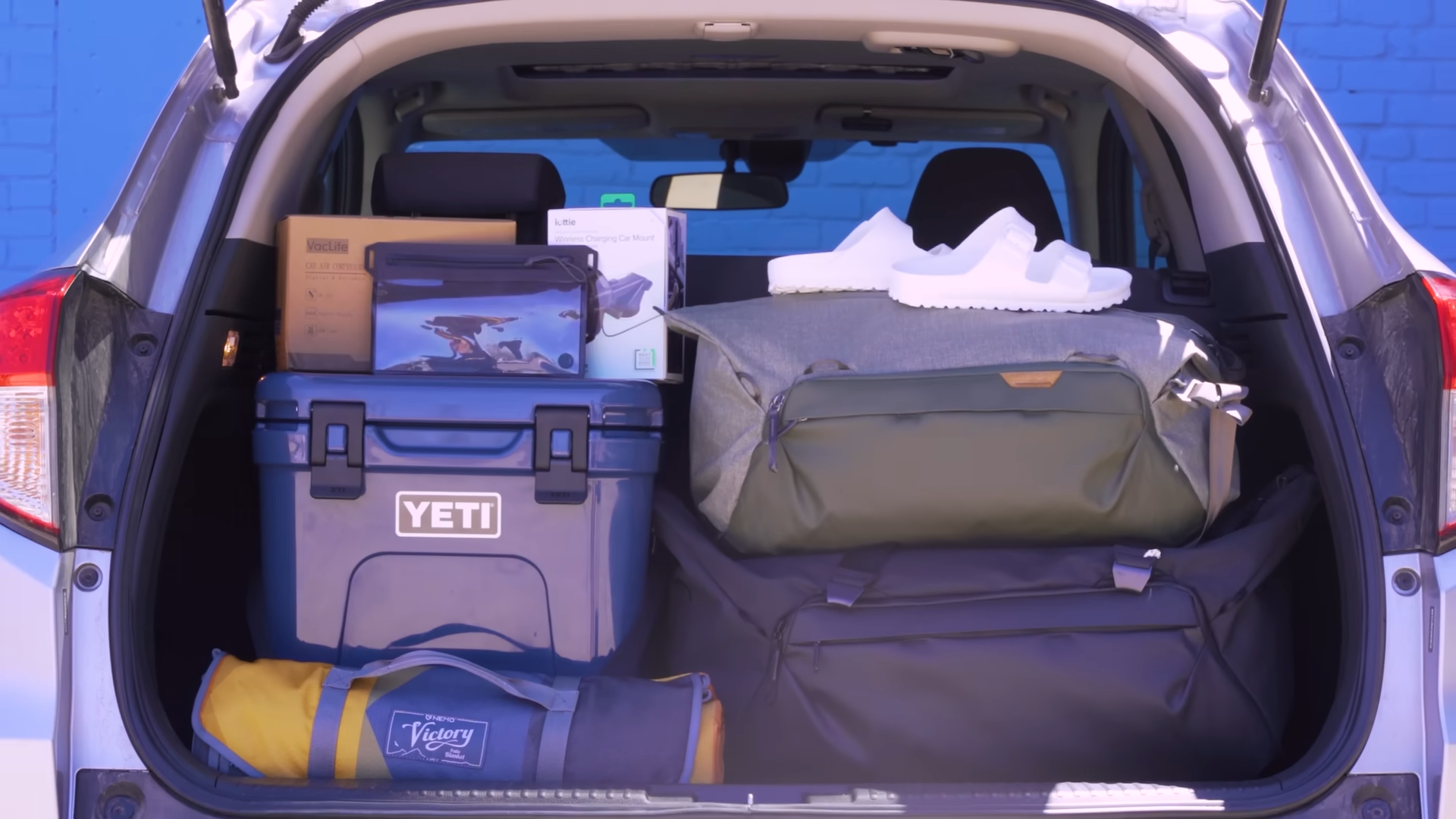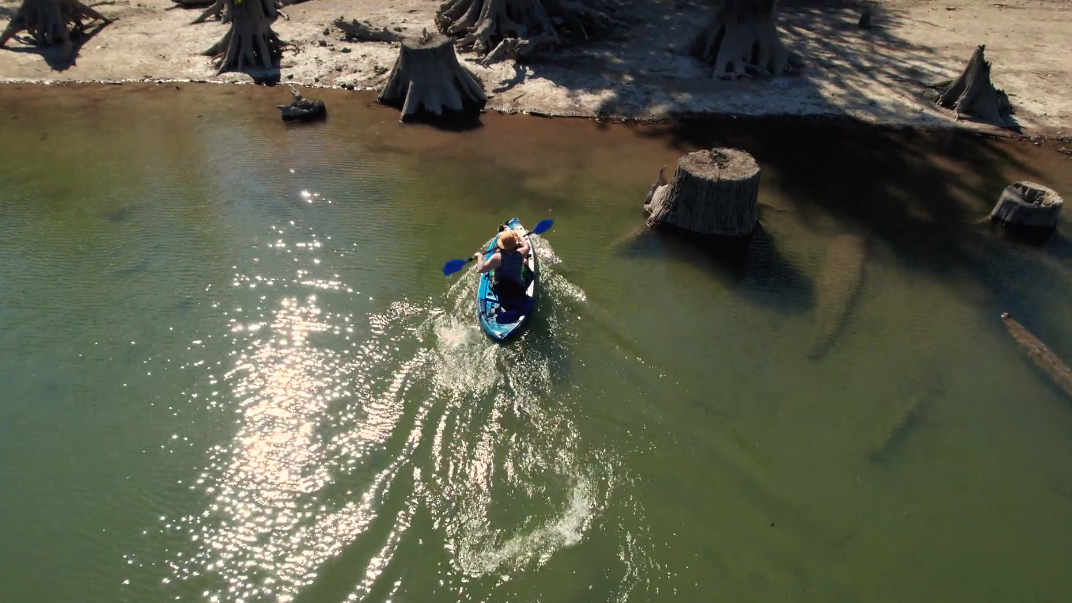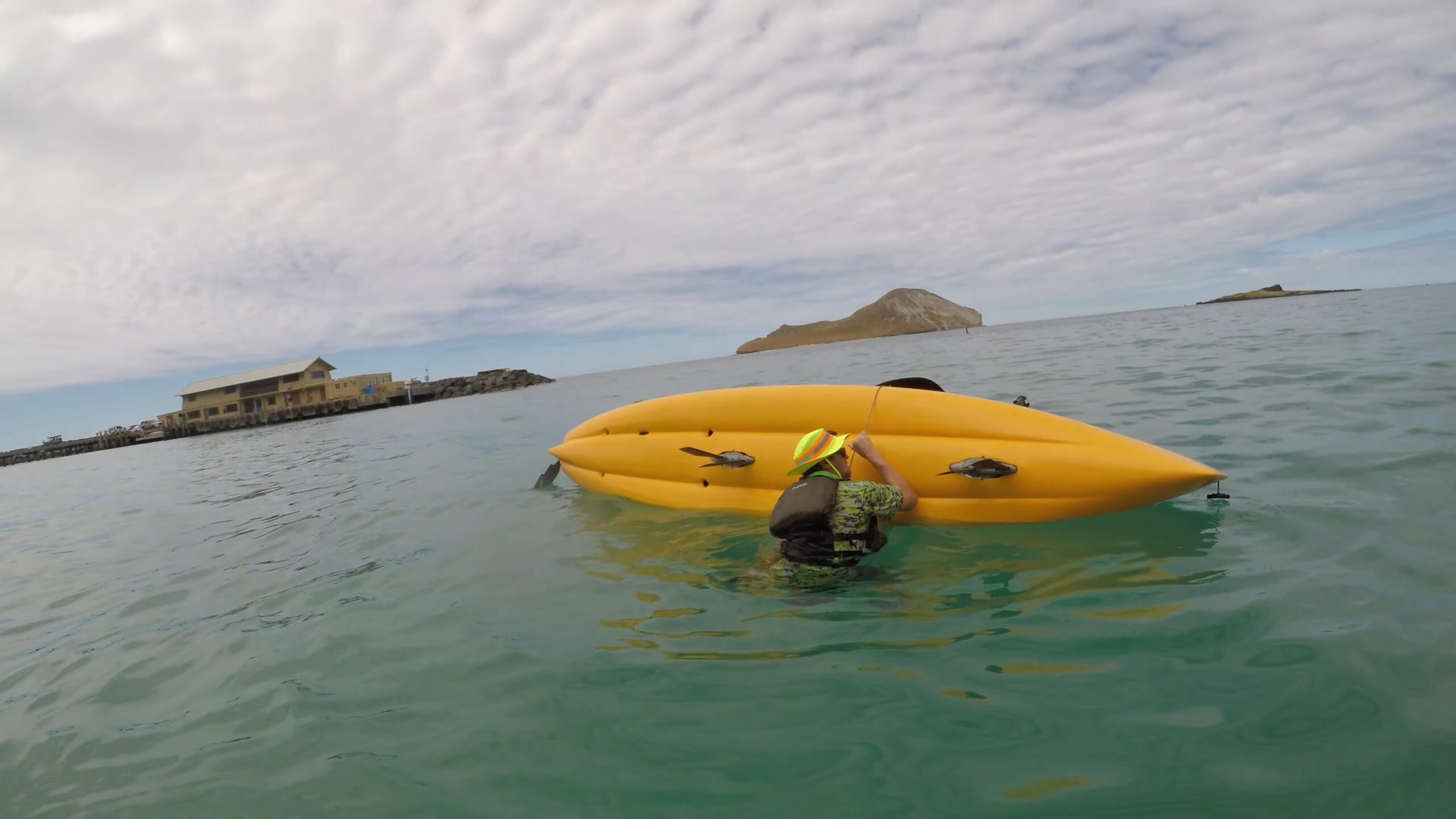As much as it can be rewarding and liberating, owning a kayak certainly comes with its own set of challenges and troubles. On one hand, you have a paddling boat that can allow you to traverse many different bodies of water. It is a fun activity on its own, but it can also expand what can be done with other popular hobbies like fishing and camping. However, on the other side, there are things that are enough for many people not to ever invest in a kayak. The biggest problems include transporting the kayak, handling it, and most of all, storing it while it is not being used.
Why are all of these things, storing in particular, such a big deal? Well, for more than one reason actually. It is in the nature of kayaks to be cumbersome and difficult to handle no matter the situation. Whenever one wants to take their kayak out for a paddle, the following scenario ensues. First, they must take it out of storage and onto/into the car/trailer. When they arrive at the destination, the kayak needs to come down and then be carried by hand to the water. This is already a lot of effort, but it needs to be done again, in reverse, when the kayaking session is over.
It is, however, the storage part that takes the cake because it implies finding a secure place in one’s home for the kayak, which will stand there for the better part of the year. Kayaking is not something one does every day unless one lives near a river, lake, or beach. Therefore, storing is prevalent, but always easy to come by. Since it is so big and difficult to handle, it is a problem to find dedicated storage. Sheds, garages, and basements are the usual places, but even then there are issues. Where do you put it and how?
Table of Contents
ToggleKayak Storing Issues
Storing kayaks properly is essential to ensure they remain in good condition and are ready to use when needed. This can be done in more than one way and not everything can be done with every type of storage. Here are some of the best tips for storing kayaks:
Keep it out of direct sunlight
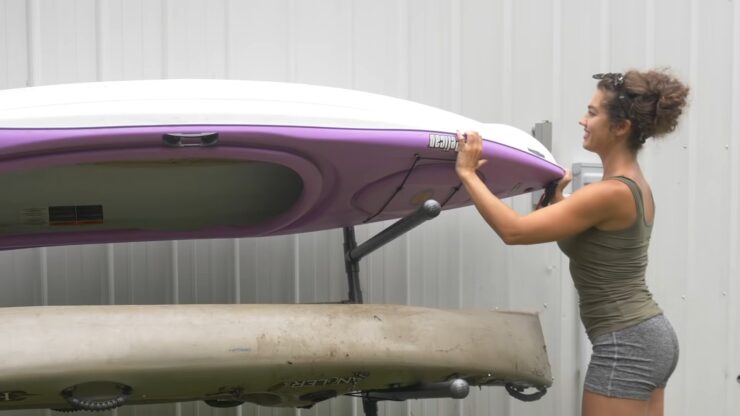
UV rays can damage polyethylene plastic and cause fading, cracking, and weakening of the materials. Sun tends to damage even the strongest and most durable items, let alone plastic. It is best to store kayaks in a cool, shaded area or indoors.
Avoid extreme temperatures
Kayaks should not be stored in areas where the temperature fluctuates greatly, as this can cause the material to expand and contract wildly and too often, leading to warping and cracking. Once the hull is warped, it is impossible to fix it.
Keep it clean
Before storing your kayak, make sure it is clean and dry every single time. This will prevent the growth of mold and mildew, which can cause damage to the kayak. It will also allow you to go straight to kayaking when you take it out of storage the next time around.
Avoid overloading
Kayaks should be stored without any additional weight on them, as this can cause the kayak to become misshapen and damage the material. While certain items like the paddle can be kept inside, make sure the gear you have is not heavy.
Use a kayak cover
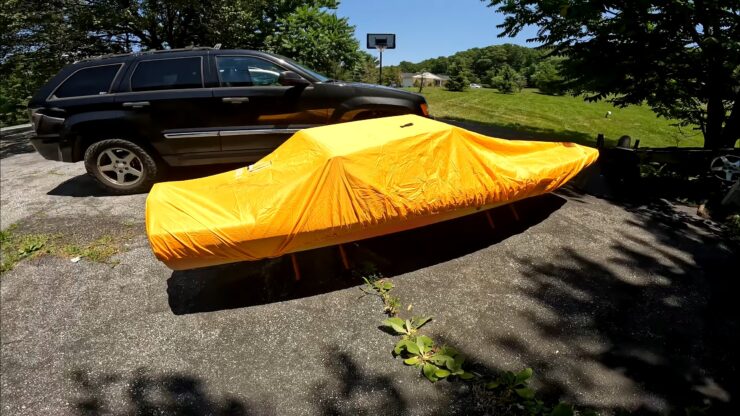
A kayak cover will protect the kayak from dust, debris, and other environmental factors that can cause damage. Make sure the cover is a proper fit for your kayak, and use a weather-resistant material. It is important inside, but crucial outside.
Use a kayak storage rack
This is where things get more serious and where this guide takes its full form. Kayak storage racks are designed to keep the kayak off the ground and upright. This prevents damage to the bottom of the kayak and keeps it in good condition. There are many types of racks available, but most are meant for indoor use. So what happens when you lack space and need to store the kayak outside?
Storing Kayaks Outside / Buyer’s Guide
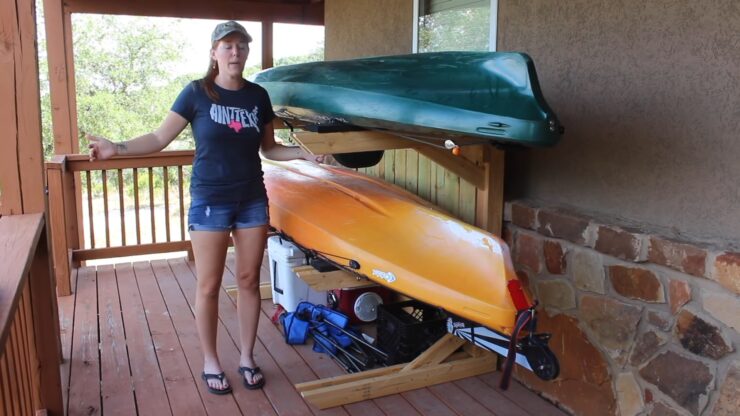
Outdoor kayak storage racks are designed to keep kayaks off the ground and upright, protecting them from damage and prolonging their lifespan. These racks can be made from a variety of materials, including wood, metal, and plastic, and come in a range of sizes and styles to suit different needs, sizes, and types of kayaks. There are different types of outdoor racks to choose from.
One popular type of outdoor kayak storage rack is the freestanding rack. These are not attached to any structure and can be easily moved to different locations. They typically consist of two or more vertical posts with horizontal crossbars for the kayaks to rest on. Some freestanding racks even come with wheels for easy mobility.
Another popular option includes the wall-mounted rack. These racks are attached to a wall or other vertical surface and use brackets to hold the kayaks in place. Wall-mounted racks are a good choice for those with limited space, as they allow kayaks to be stored out of the way while taking up minimal floor space.
Ceiling-mounted racks are a neat option that allows the kayak to be stored above ground level. These are made of metal and are attached to the ceiling or rafters of a garage or shed. These racks are perfect for people with high ceilings who want to maximize space.
A newer, more modern type of outdoor kayak storage rack is the floating rack. This one is designed to be anchored in a body of water and can be used to store kayaks, canoes, and other small boats. Floating racks are a great option for kayakers who want to keep their boats close to the water, especially those who live close to the water they regularly paddle in.
Product Reviews
1. Surf to Summit Webbing Hanger Strap
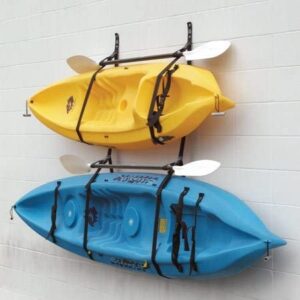
The simplest and the most straightforward solution is often the best course of action, especially with things that are already too complicated. This hanger strap kayak rack proves it. It is a wall-mounted storage solution that handles two kayaks at once. Made of heavy-duty webbing two inches thick, it has easy-release security and side-squeeze buckles.
This rack also has handy holders for your paddles that are adjustable and have Velcro loops. Four mounting screws are included which work well with wooden walls. The maximum weight capacity of this rack is 50 pounds per rack (100 in total), it is all black, and it is perfect for a wooden shed or any wooden surface you have on your property.
2. Suspenz Universal Portable Stands

Drilling holes into surfaces and hanging the kayaks on walls is not the only way to properly store them outdoors. If you want to escape this and use something a bit easier and simpler, how about a freestanding, portable boat stand that can be placed anywhere? Made of lightweight aluminum framing held together with stainless steel hardware, these yellow stands are great for anyone who wants to switch things up and move the kayaks according to their needs.
The total weight capacity of these stands is 100 pounds, they have rubber padding, and they fold to save storage when not in use. You also get a mesh carry bag for easier transportation. The stand is 17 inches high, it has rubber feet for more grip and stability, and there is strong webbing between the arms for the kayak to sit in. The frame is bright yellow and easily noticeable, while everything else is black.
3. Suspenz EZ Kayak Rack Wall Mount
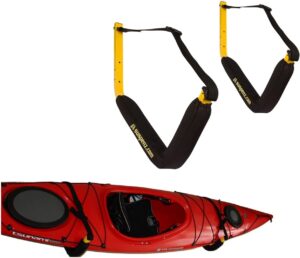
If you like the Suspenz brand but still want to keep your kayaks on a wall, here is their solution. Sporting the same yellow and black color combo, this wall storage extends 20 inches from the wall and is made of a powder-coated steel frame. There are reinforced safety straps that hold the boat in place. In charge of comfort and safety is nylon-covered foam padding.
The storage can hold up to 125 pounds of weight and the kayaks are stored on their side. If you ever find space, this rack can also be used indoors. It is very easy to install and there are quick-release wall brackets available. Overall, this rack is universal enough to be placed on walls, but also fences and even posts/beams.
4. RAD Sports Double Kayak Storage Rack
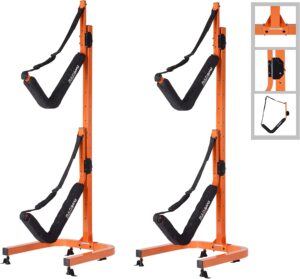
For something more professional, universal, and versatile, here is a storage solution consisting of two separate racks that can be placed wherever you want. Two kayaks can comfortably sit in a vertical position, saving plenty of space in the yard. Independent from each other, the distance between them can be customized thanks to the adjustable height of the racks. This is handy if you have different kayaks that require more room.
The racks are made of durable steel tubing and make use of hooks that can each carry up to 100 pounds. In total, that is 200 pounds of kayaks to store on this amazing outdoor rack. Despite this great capacity, they are quite lightweight and can be easily moved around the property. The metal frame is orange while the straps and the padding are black. Wheels can be attached to the bottom, but they do sell separately. Each rack is 53.1 x 24 x 24 inches.
5. Log Kayak Wooden Rack
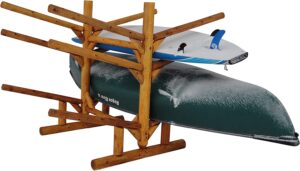
Now, this is a unique take on modern outdoor kayak storage, one obviously inspired by how things used to be done back in the day. If you care about aesthetics and want your forest lodge to be in tune with the nature around it, this wooden rack stores 4 kayaks and two boards at once. Made of strong and durable cedar wood, it comes in canyon brown, natural, and unfinished color varieties.
The total kayak weight you can put on it is 100 pounds per boat (600 in total). Its measurements are 64 x 84 x 77 inches, making it the biggest rack on the list. It is certainly the most stylish and eye-catching, too. Handmade and finished, they are made exclusively in Wisconsin, and assembly is required when it arrives.
It is a hefty investment because natural wood is expensive, and it can be a handful to treat and handle. First of all, it weighs an astonishing 135 pounds on its own. While the white cedar is resistant to decay, termites and beetles, humidity, and the elements are still able to damage it beyond repair unless it is maintained the right way. But hey, that is the case with everything made of real wood.
How to Choose?
Outdoor kayak storage racks are an essential piece of equipment for any kayaker. They keep the kayaks off the ground and upright, protecting them from all sorts of damage and keeping them operational for longer. There are many sizes and kayak types, kayaker lifestyles, and outdoor conditions. When choosing an outdoor kayak storage rack, the kayakers should consider the number of kayaks they need to store, the size and weight of their kayaks, and the location where the rack will be placed when choosing an outdoor kayak storage rack. It is also important to ensure that the rack is made of durable, weather-resistant materials and is designed to hold the weight of your kayaks safely.
Conclusion and Takeaways
Following these tips and picking one of the aforementioned storage racks ensures that your kayak is stored properly and remains in good condition for years to come. A well-maintained kayak is safer, more reliable, and will last longer, even if you have to keep it outside. If you have the right rack and know how to take care of your boat properly, there will be nothing stopping it from lasting. Regularly check the kayak for any signs of damage or wear and tear, and address issues as soon as they arise. Think about using a cover because it is being kept outside after all, as it can only contribute to optimal storage conditions.
Hi, I’m Jonathan Clayton, a seasoned writer with a deep-seated love for canoeing and kayaking. When I’m not navigating the waterways, I’m here at KayakPaddling.net, sharing my adventures and inspiring others to dive into the world of paddling.
Related Posts:
- 16 Best Kayak For Beginners 2024 - Kayaking Adventure Gear
- 10 Best Inflatable Kayak 2024 - Rivers, Lakes & Open Seas
- Heavy Duty Fishing: 11 Best Rods And Reels For Big Fish 2024
- 10 Best Kayaks For Camping 2024 - Lightweight and…
- 12 Best Motorized Kayak 2024 - Start Your Aquatic Adventure!
- 12 Best Truck Bed Hitch Extenders for Kayak 2024 -…

